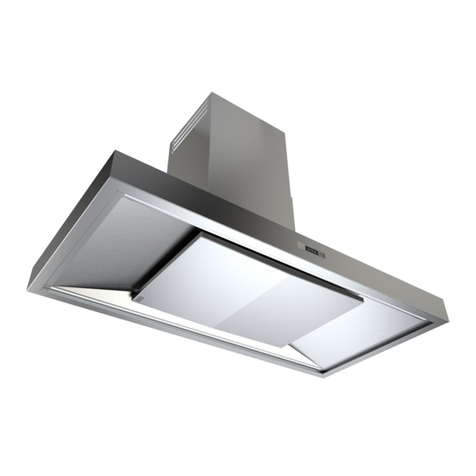W2071 WSW MASTERCHEF (Energy Label Version) V1 20220310.docx Page 2
1. INTRODUCTION
During the cooking process, there will be heat, vapours and fumes
produced. Your Extractor has been designed to complement your
kitchen both in looks and performance in order to create a good
environment for creative cooking.
2. IMPORTANT INFORMATION
The exhaust air must not be discharged into a flue which is used
for exhausting fumes from non-electric appliances such as oil or
gas-fired central heating boilers or gas-fired water heaters, etc.
Requirements of the relevant authorities concerning the discharge
of exhaust air must be complied with.
Pay particular attention to fire risk when frying. To minimise the risk
of fire, all instructions relating to cleaning the grease filters and
removing grease deposits must be adhered to.
Do not flambé under the extractor.
The clearance between the hob burners and the bottom
surface of the cooker hood (extractor) should be within the
following range, unless a greater distance is specified by the
cooking appliance manufacturer:
Hob to underside of the cooker hood clearance distances:
•650mm minimum above electric hobs.
•760mm minimum above all gas hobs and gas or electric wok
burners, griddles, fryers, open grills / barbeques.
•850mm is the maximum recommended distance between the
hob and underside of the cooker hood.
The minimum distance between the hob and the bottom of the
cooker hood is essential for safety reasons and to prevent
overheating of the extractor and its components.
Exceeding the maximum clearance distance will reduce how
efficiently the cooker hood removes cooking fumes and odours.
You are advised to install measures designed to reduce the
incidence of cold draughts entering the property via any
ductwork.
For extractors with internal or inline fans, this should (at the very
least) consist of an external duct termination with integrated non-
return flaps (e.g. gravity shutter wall grille/louvre) and/or an inline
backdraught shutter.
For wall-mounted fans an inline backdraught shutter is
recommended.
3. EXTRACTION PERFORMANCE
The primary influence on the overall performance of the
extractor is the design of the ducting which takes the exhaust
air from the extractor to the outside. The duct route should be
a prime consideration during the initial stages of the kitchen
design (The manufacturer does not recommend recirculating
air back into the kitchen).
Please note the following:
•Easy access to the duct route during installation is
important. Lack of access may require the “blind” fitting of
flexible ducting, with increased risk of unseen kinks and
impaired efficiency.
•The extractor is provided with a spigot (or spigots) suitable
for connecting the ducting (Usually 150mm diameter).
Because this is a bespoke product, alternative
arrangements may have been agreed during the design
phase for connection of your ducting.
•Note: the cross-sectional area of the agreed duct size
should not be reduced as this seriously reduces extraction
efficiency.
•The most efficient configuration is to duct straight through
an outside wall so try to position the cooker against an
outside wall when designing your kitchen.
•If your extractor has adjustable exhaust positions then use
the exhaust position which gives the shortest achievable
duct route and least number of bends.
•Well installed, correctly sized rigid round ducting or an
equivalent flat channel system will usually perform best,
with round semi-rigid ducting being an alternative. Flexible
ducting is economical but its use should be minimised as it
gives the worst performance and should only be used for
short duct runs or initial connection and should be pulled
taut to prevent significant losses in extraction efficiency.
•For maximum efficiency, ducting should be kept as short
and as straight as possible with a constant cross-sectional
area being no less than that recommended by the
manufacturer. Bends in the duct will degrade performance
so the number of bends in a duct run should be kept to a
minimum and be gradual and smooth to prevent turbulence.
Avoid kinks in flexible ducting. Pulling the ducting taut over
straight runs will ensure that the internal surface is as
smooth as possible.
•If using rigid ducting you may wish to consider making the
initial duct connection to the extractor using semi-rigid (or
flexible, if unavoidable) round ducting to facilitate easier
installation and future maintenance.
If the duct spigot is accessible with the unit installed and it
will remain so in the completed kitchen (e.g. behind a
removable chimney) then no flexible connection need be
used.
•Ducting and associated components, including complete
kits are generally available.




































